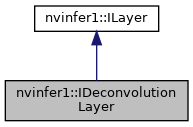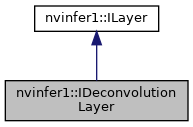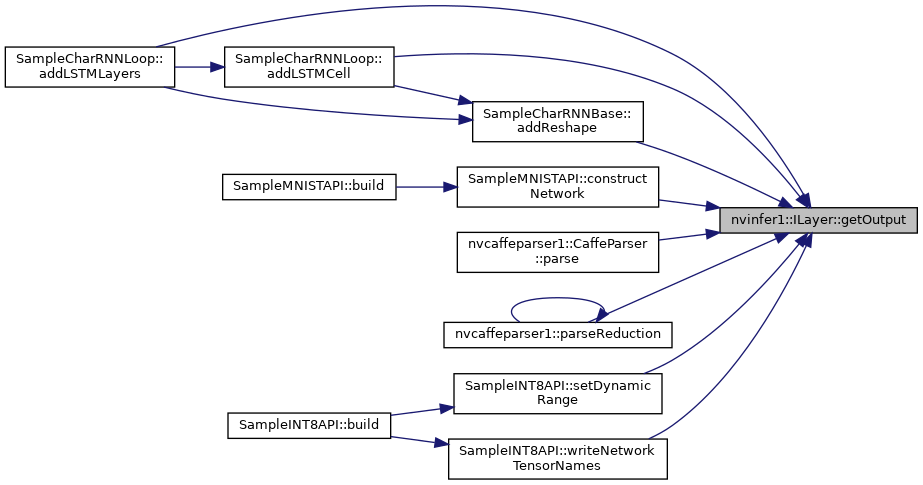A deconvolution layer in a network definition. More...


Public Member Functions | |
| __attribute__ ((deprecated)) virtual void setKernelSize(DimsHW kernelSize)=0 | |
| Set the HW kernel size of the convolution. More... | |
| __attribute__ ((deprecated)) virtual DimsHW getKernelSize() const =0 | |
| Get the HW kernel size of the deconvolution. More... | |
| virtual void | setNbOutputMaps (int32_t nbOutputMaps)=0 |
| Set the number of output feature maps for the deconvolution. More... | |
| virtual int32_t | getNbOutputMaps () const =0 |
| Get the number of output feature maps for the deconvolution. More... | |
| __attribute__ ((deprecated)) virtual void setStride(DimsHW stride)=0 | |
| Get the stride of the deconvolution. More... | |
| __attribute__ ((deprecated)) virtual DimsHW getStride() const =0 | |
| Get the stride of the deconvolution. More... | |
| __attribute__ ((deprecated)) virtual void setPadding(DimsHW padding)=0 | |
| Set the padding of the deconvolution. More... | |
| __attribute__ ((deprecated)) virtual DimsHW getPadding() const =0 | |
| Get the padding of the deconvolution. More... | |
| virtual void | setNbGroups (int32_t nbGroups)=0 |
| Set the number of groups for a deconvolution. More... | |
| virtual int32_t | getNbGroups () const =0 |
| Get the number of groups for a deconvolution. More... | |
| virtual void | setKernelWeights (Weights weights)=0 |
| Set the kernel weights for the deconvolution. More... | |
| virtual Weights | getKernelWeights () const =0 |
| Get the kernel weights for the deconvolution. More... | |
| virtual void | setBiasWeights (Weights weights)=0 |
| Set the bias weights for the deconvolution. More... | |
| virtual Weights | getBiasWeights () const =0 |
| Get the bias weights for the deconvolution. More... | |
| virtual void | setPrePadding (Dims padding)=0 |
| Set the multi-dimension pre-padding of the deconvolution. More... | |
| virtual Dims | getPrePadding () const =0 |
| Get the pre-padding. More... | |
| virtual void | setPostPadding (Dims padding)=0 |
| Set the multi-dimension post-padding of the deconvolution. More... | |
| virtual Dims | getPostPadding () const =0 |
| Get the padding. More... | |
| virtual void | setPaddingMode (PaddingMode paddingMode)=0 |
| Set the padding mode. More... | |
| virtual PaddingMode | getPaddingMode () const =0 |
| Get the padding mode. More... | |
| virtual void | setKernelSizeNd (Dims kernelSize)=0 |
| Set the multi-dimension kernel size of the deconvolution. More... | |
| virtual Dims | getKernelSizeNd () const =0 |
| Get the multi-dimension kernel size of the deconvolution. More... | |
| virtual void | setStrideNd (Dims stride)=0 |
| Set the multi-dimension stride of the deconvolution. More... | |
| virtual Dims | getStrideNd () const =0 |
| Get the multi-dimension stride of the deconvolution. More... | |
| virtual void | setPaddingNd (Dims padding)=0 |
| Set the multi-dimension padding of the deconvolution. More... | |
| virtual Dims | getPaddingNd () const =0 |
| Get the multi-dimension padding of the deconvolution. More... | |
| void | setInput (int32_t index, ITensor &tensor)=0 |
| Append or replace an input of this layer with a specific tensor. More... | |
| virtual void | setDilationNd (Dims dilation)=0 |
| Set the multi-dimension dilation of the deconvolution. More... | |
| virtual Dims | getDilationNd () const =0 |
| Get the multi-dimension dilation of the deconvolution. More... | |
| virtual LayerType | getType () const =0 |
| Return the type of a layer. More... | |
| virtual void | setName (const char *name)=0 |
| Set the name of a layer. More... | |
| virtual const char * | getName () const =0 |
| Return the name of a layer. More... | |
| virtual int32_t | getNbInputs () const =0 |
| Get the number of inputs of a layer. More... | |
| virtual ITensor * | getInput (int32_t index) const =0 |
| Get the layer input corresponding to the given index. More... | |
| virtual int32_t | getNbOutputs () const =0 |
| Get the number of outputs of a layer. More... | |
| virtual ITensor * | getOutput (int32_t index) const =0 |
| Get the layer output corresponding to the given index. More... | |
| virtual void | setPrecision (DataType dataType)=0 |
| Set the computational precision of this layer. More... | |
| virtual DataType | getPrecision () const =0 |
| get the computational precision of this layer More... | |
| virtual bool | precisionIsSet () const =0 |
| whether the computational precision has been set for this layer More... | |
| virtual void | resetPrecision ()=0 |
| reset the computational precision for this layer More... | |
| virtual void | setOutputType (int32_t index, DataType dataType)=0 |
| Set the output type of this layer. More... | |
| virtual DataType | getOutputType (int32_t index) const =0 |
| get the output type of this layer More... | |
| virtual bool | outputTypeIsSet (int32_t index) const =0 |
| whether the output type has been set for this layer More... | |
| virtual void | resetOutputType (int32_t index)=0 |
| reset the output type for this layer More... | |
Protected Member Functions | |
| virtual | ~IDeconvolutionLayer () |
A deconvolution layer in a network definition.
The output size is defined using the formula set by INetworkDefinition::setDeconvolutionOutputDimensionsFormula().
|
inlineprotectedvirtual |
|
pure virtual |
Set the HW kernel size of the convolution.
If executing this layer on DLA, both height and width of kernel size must be in the range [1,32], or the combinations of [64, 96, 128] in one dimension and 1 in the other dimensions, i.e. [1x64] or [64x1] are valid, but not [64x64].
|
pure virtual |
Get the HW kernel size of the deconvolution.
|
pure virtual |
Set the number of output feature maps for the deconvolution.
If executing this layer on DLA, the number of output maps must be in the range [1,8192].
|
pure virtual |
Get the number of output feature maps for the deconvolution.
|
pure virtual |
Get the stride of the deconvolution.
If executing this layer on DLA, both height and width of stride must be in the range [1,32] or the combinations of [64, 96, 128] in one dimension and 1 in the other dimensions, i.e. [1x64] or [64x1] are valid, but not [64x64].
|
pure virtual |
Get the stride of the deconvolution.
Default: (1,1)
|
pure virtual |
Set the padding of the deconvolution.
The output will be trimmed by this number of elements on each side in the height and width directions. In other words, it resembles the inverse of a convolution layer with this padding size. Padding is symmetric, and negative padding is not supported.
Default: (0,0)
If executing this layer on DLA, both height and width of padding must be 0.
|
pure virtual |
Get the padding of the deconvolution.
Default: (0, 0)
|
pure virtual |
Set the number of groups for a deconvolution.
The input tensor channels are divided into nbGroups groups, and a deconvolution is executed for each group, using a filter per group. The results of the group convolutions are concatenated to form the output.
If executing this layer on DLA, nbGroups must be one
Default: 1
|
pure virtual |
Get the number of groups for a deconvolution.
|
pure virtual |
Set the kernel weights for the deconvolution.
The weights are specified as a contiguous array in CKRS order, where C the number of input channels, K the number of output feature maps, and R and S are the height and width of the filter.
|
pure virtual |
Get the kernel weights for the deconvolution.
|
pure virtual |
Set the bias weights for the deconvolution.
Bias is optional. To omit bias, set the count value of the weights structure to zero.
The bias is applied per-feature-map, so the number of weights (if non-zero) must be equal to the number of output feature maps.
|
pure virtual |
Get the bias weights for the deconvolution.
|
pure virtual |
Set the multi-dimension pre-padding of the deconvolution.
The output will be trimmed by this number of elements on the start of every dimension. In other words, it resembles the inverse of a convolution layer with this padding size. Negative padding is not supported.
Default: (0, 0, ..., 0)
If executing this layer on DLA, padding must be 0.
|
pure virtual |
Get the pre-padding.
|
pure virtual |
Set the multi-dimension post-padding of the deconvolution.
The output will be trimmed by this number of elements on the end of every dimension. In other words, it resembles the inverse of a convolution layer with this padding size. Negative padding is not supported.
Default: (0, 0, ..., 0)
If executing this layer on DLA, padding must be 0.
|
pure virtual |
Get the padding.
|
pure virtual |
Set the padding mode.
Padding mode takes precedence if both setPaddingMode and setPre/PostPadding are used.
Default: kEXPLICIT_ROUND_DOWN
|
pure virtual |
|
pure virtual |
Set the multi-dimension kernel size of the deconvolution.
If executing this layer on DLA, only support 2D kernel size, both height and width of kernel size must be in the range [1-32].
|
pure virtual |
Get the multi-dimension kernel size of the deconvolution.
|
pure virtual |
Set the multi-dimension stride of the deconvolution.
Default: (1, 1, ..., 1)
If executing this layer on DLA, only support 2D stride, both height and width of stride must be in the range [1-32].
|
pure virtual |
Get the multi-dimension stride of the deconvolution.
|
pure virtual |
Set the multi-dimension padding of the deconvolution.
The output will be trimmed by this number of elements on both sides of every dimension. In other words, it resembles the inverse of a convolution layer with this padding size. Padding is symmetric, and negative padding is not supported.
Default: (0, 0, ..., 0)
If executing this layer on DLA, padding must be 0.
|
pure virtual |
Get the multi-dimension padding of the deconvolution.
If the padding is asymmetric, the pre-padding is returned.
|
pure virtual |
Append or replace an input of this layer with a specific tensor.
| index | the index of the input to modify. |
| tensor | the new input tensor |
For a IDeconvolutionLayer, only index 0 is valid unless explicit precision mode is enabled. With explicit precision mode, values 0-1 are valid where value 1 overrides kernel weights. Kernel weights tensor (computed at build-time) must be an output of dequantize scale layer (i.e. a scale layer with int8 input and float output) in explicit precision network. Conversely, this input tensor can be overridden via appropriate set call. The indices are as follows:
If this function is called with a value greater than 0, then the function getNbInputs() changes
Implements nvinfer1::ILayer.
|
pure virtual |
Set the multi-dimension dilation of the deconvolution.
Default: (1, 1, ..., 1)
|
pure virtual |
Get the multi-dimension dilation of the deconvolution.
|
pure virtualinherited |
Return the type of a layer.
|
pure virtualinherited |
Set the name of a layer.
This method copies the name string.

|
pure virtualinherited |
|
pure virtualinherited |
Get the number of inputs of a layer.
|
pure virtualinherited |
Get the layer input corresponding to the given index.
| index | The index of the input tensor. |
|
pure virtualinherited |
Get the number of outputs of a layer.

|
pure virtualinherited |
Get the layer output corresponding to the given index.

|
pure virtualinherited |
Set the computational precision of this layer.
Setting the precision allows TensorRT to choose implementation which run at this computational precision. Layer input type would also get inferred from layer computational precision. TensorRT could still choose a non-conforming fastest implementation ignoring set layer precision. Use BuilderFlag::kSTRICT_TYPES to force choose implementations with requested precision. In case no implementation is found with requested precision, TensorRT would choose available fastest implementation. If precision is not set, TensorRT will select the layer computational precision and layer input type based on performance considerations and the flags specified to the builder.
| precision | the computational precision. |
|
pure virtualinherited |
get the computational precision of this layer
|
pure virtualinherited |
whether the computational precision has been set for this layer
|
pure virtualinherited |
reset the computational precision for this layer
|
pure virtualinherited |
Set the output type of this layer.
Setting the output type constrains TensorRT to choose implementations which generate output data with the given type. If it is not set, TensorRT will select output type based on layer computational precision. TensorRT could still choose non-conforming output type based on fastest implementation. Use BuilderFlag::kSTRICT_TYPES to force choose requested output type. In case layer precision is not specified, output type would depend on chosen implementation based on performance considerations and the flags specified to the builder.
This method cannot be used to set the data type of the second output tensor of the TopK layer. The data type of the second output tensor of the topK layer is always Int32. Also the output type of all layers that are shape operations must be DataType::kINT32, and all attempts to set the output type to some other data type will be ignored except for issuing an error message.
Note that the layer output type is generally not identical to the data type of the output tensor, as TensorRT may insert implicit reformatting operations to convert the former to the latter. Calling layer->setOutputType(i, type) has no effect on the data type of the i-th output tensor of layer, and users need to call layer->getOutput(i)->setType(type) to change the tensor data type. This is particularly relevant if the tensor is marked as a network output, since only setType() [but not setOutputType()] will affect the data representation in the corresponding output binding.
| index | the index of the output to set |
| dataType | the type of the output |
|
pure virtualinherited |
get the output type of this layer
| index | the index of the output |
|
pure virtualinherited |
whether the output type has been set for this layer
| index | the index of the output |
|
pure virtualinherited |
reset the output type for this layer
| index | the index of the output |